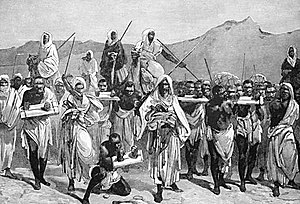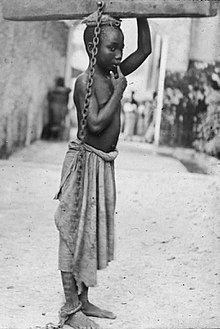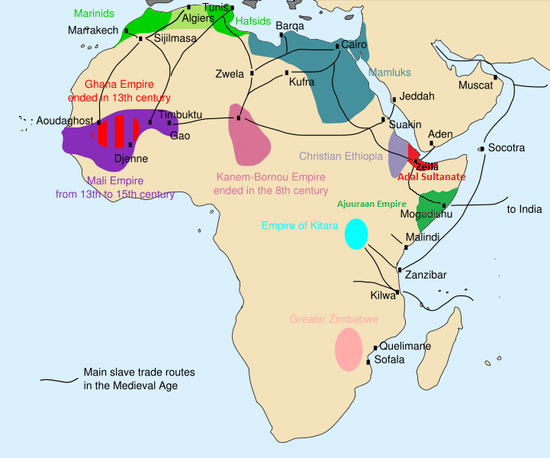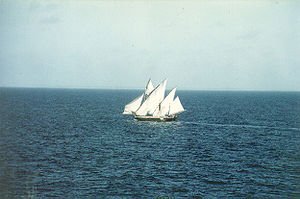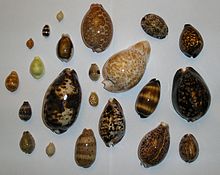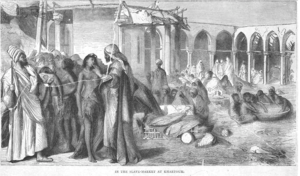19th-century engraving depicting an Arab slave-trading caravan transporting black African slaves across the Sahara.
The Arab slave trade was the intersection of slavery and trade in the Arab world, mainly in Western Asia, North Africa, East Africa, India and Europe.
This barter occurred chiefly between the medieval era and the early
20th century. The trade was conducted through slave markets in these
areas, with the slaves captured mostly from Africa's interior and Southern Europe.
Walter Rodney argues that the term Arab Slave Trade is a historical misnomer since bilateral trade agreements between myriad ethnic groups across the proposed 'Zanj trade network' characterized much of the acquisition process of chattel, and more often than not indentured servants.
Scope of the trade
African Zanj slaves
Arab slave traders and their captives along the Ruvuma River in Mozambique.
The Arab slave trade, across the Sahara desert and across the Indian Ocean, began after Muslim Arab and Swahili traders won control of the Swahili Coast and sea routes during the 9th century (see Sultanate of Zanzibar). These traders captured Bantu peoples (Zanj) from the interior in present-day Kenya, Mozambique and Tanzania and brought them to the coast. There, the slaves gradually assimilated in the rural areas, particularly on the Unguja and Pemba islands.
Some historians assert that as many as 17 million people were
sold into slavery on the coast of the Indian Ocean, the Middle East, and
North Africa, and approximately 5 million African slaves were
transported by Muslim slave traders via Red Sea, Indian Ocean, and Sahara desert to other parts of the world between 1500 and 1900.
The captives were sold throughout the Middle East. This trade
accelerated as superior ships led to more trade and greater demand for
labour on plantations in the region. Eventually, tens of thousands of captives were being taken every year.
The Indian Ocean slave trade was multi-directional and changed
over time. To meet the demand for menial labor, Bantu slaves bought by
Arab slave traders from southeastern Africa were sold in cumulatively
large numbers over the centuries to customers in Egypt, Arabia, the Persian Gulf, India, European colonies in the Far East, the Indian Ocean islands, Ethiopia and Somalia.
Slave labor in East Africa was drawn from the Zanj, Bantu peoples that lived along the East African coast. The Zanj were for centuries shipped as slaves by Arab traders to all the countries bordering the Indian Ocean. The Umayyad and Abbasid caliphs recruited many Zanj slaves as soldiers and, as early as 696, there were revolts of Zanj slave soldiers in Iraq. A 7th-century Chinese text mentions ambassadors from Java presenting the Chinese emperor with two Seng Chi (Zanj) slaves as gifts in 614, and 8th- and 9th-century chronicles mention Seng Chi slaves reaching China from the Hindu kingdom of Sri Vijaya in Java.
The Zanj Rebellion, a series of uprisings that took place between 869 and 883 AD near the city of Basra (also known as Basara), situated in present-day Iraq, is believed to have involved enslaved Zanj that had originally been captured from the African Great Lakes region and areas further south in East Africa. It grew to involve over 500,000 slaves and free men who were imported from across the Muslim empire and claimed over "tens of thousands of lives in lower Iraq".
The Zanj who were taken as slaves to the Middle East were often used in strenuous agricultural work. As the plantation economy boomed and the Arabs became richer, agriculture and other manual labor work was thought to be demeaning. The resulting labor shortage led to an increased slave market.
It is certain that large numbers of slaves were exported from eastern Africa; the best evidence for this is the magnitude of the Zanj revolt in Iraq in the 9th century, though not all of the slaves involved were Zanj. There is little evidence of what part of eastern Africa the Zanj came from, for the name is here evidently used in its general sense, rather than to designate the particular stretch of the coast, from about 3°N. to 5°S., to which the name was also applied.
The Zanj were needed to take care of:
the Tigris-Euphrates delta, which had become abandoned marshland as a result of peasant migration and repeated flooding, could be reclaimed through intensive labor. Wealthy proprietors "had received extensive grants of tidal land on the condition that they would make it arable." Sugar cane was prominent among the products of their plantations, particularly in Khūzestān Province. Zanj also worked the salt mines of Mesopotamia, especially around Basra.
Their jobs were to clear away the nitrous topsoil that made the land
arable. The working conditions were also considered to be extremely
harsh and miserable. Many other people were imported into the region,
besides Zanj.
Historian M. A. Shaban has argued that rebellion was not a slave revolt, but a revolt of blacks (zanj).
In his opinion, although a few runaway slaves did join the revolt, the
majority of the participants were Arabs and free Zanj. If the revolt had
been led by slaves, they would have lacked the necessary resources to
combat the Abbasid government for as long as they did.
Ibn Battuta who visited the ancient African kingdom of Mali
in the mid-14th century recounts that the local inhabitants vie with
each other in the number of slaves and servants they have, and was
himself given a slave boy as a "hospitality gift."
European slaves
A Hejazi Meccan merchant (right) and his Circassian slave, between 1886 and 1887
During the Middle Ages, the main regions from where slaves were transported to Muslim lands were Central Europe asides from Central Asia and Bilad as-Sudan. Slaves of Northwestern Europe
were also favoured. This slave trade was controlled mostly by Western
slave traders. The Slavs captured by Christians were sent to Muslim
lands like Spain and Egypt through France and Venice. Prague served as a major centre for castration of Slavic captives. Emirate of Bari also served as an important port for trade of such slaves. After the Byzantine Empire and Venice blocked Arab merchants from European ports, they started importing in slaves from Caucasus and Caspian Sea.
Arabs also enslaved Europeans directly. According to Robert
Davis, between 1 million and 1.25 million Europeans were captured
between the 16th and 19th centuries by Barbary corsairs, who were vassals of the Ottoman Empire, and sold as slaves. These slaves were captured mainly from seaside villages from Italy, Spain, Portugal, Ireland, and also from more distant places like France or England, the Netherlands, and even Iceland. They were also taken from ships stopped by the pirates. The most prominent Barbary pirates were European renegades.
The effects of these attacks
were devastating: France, England, and Spain each lost thousands of
ships. Long stretches of the Spanish and Italian coasts were almost
completely abandoned by their inhabitants, because of frequent pirate
attacks. Pirate raids discouraged settlement along the coast until the
19th century.
Periodic Muslim raiding expeditions were sent from Islamic Iberia to ravage the Christian Iberian kingdoms, bringing back slaves. In a raid against Lisbon in 1189, for example, the Almohad Berber Muslim caliph, Abu Yusuf Yaqub al-Mansur, took 3,000 female and child captives, while his governor of Córdoba, in a subsequent attack upon Silves in 1191, took 3,000 Christian slaves.
Arab slaves
Arabs were sometimes made into slaves in the Muslim world. Sometimes castration was done on Arab slaves. In Mecca, Arab women were sold as slaves according to Ibn Butlan, and certain rulers in West Africa had slave girls of Arab origin. According to al-Maqrizi, slave girls with lighter skin were sold to West Africans on hajj.
Ibn Battuta met an Arab slave girl near Timbuktu in Mali in 1353.
Battuta wrote that the slave girl was fluent in Arabic, from Damascus,
and her master's name was Farbá Sulaymán. Besides his Damascus slave girl and a secretary fluent in Arabic, Arabic was also understood by Farbá himself.
Islamic and Oriental aspect
Patrick Manning writes that although the "Oriental" or "Arab" slave trade is sometimes called the "Islamic" slave trade,
a religious imperative was not the driver of the slavery. He further
argues such use of the terms "Islamic trade" or "Islamic world"
erroneously treats Africa as being outside Islam, or a negligible
portion of the Islamic world. According to European historians, propagators of Islam in Africa often revealed a cautious attitude towards proselytizing because of its effect in reducing the potential reservoir of slaves.
The subject merges with the Oriental slave trade, which followed two main routes in the Middle Ages:
- Overland routes across the Maghreb and Mashriq deserts (Trans-Saharan route)
- Sea routes to the east of Africa through the Red Sea and Indian Ocean (Oriental route)
The Arab slave trade originated before Islam and lasted more than a millennium. To meet the demand for plantation labor, these captured Zanj slaves were shipped to the Arabian peninsula and the Near East, among other areas.
History of the Arab slave trade
African Zanj slaves
The Arab trade of Zanj (Bantu) slaves in Southeast Africa is one of the oldest slave trades, predating the European transatlantic slave trade by 700 years.
Male slaves were often forced to work as servants, soldiers, or
laborers by their owners, while female slaves, including those from
Africa, were long traded to the Middle Eastern countries and kingdoms by
Arab and Oriental traders as concubines and servants. Arab, African and Oriental
traders were involved in the capture and transport of slaves northward
across the Sahara desert and the Indian Ocean region into the Middle
East, Persia and the Far East.
From the 7th century until around the 1960s, the Arab slave trade
continued in one form or another. Historical accounts and references to
slave-owning nobility in Arabia, Yemen and elsewhere are frequent into the early 1920s.
In 641 during the Baqt, a treaty between the Nubian Christian state of Makuria
and the new Muslim rulers of Egypt, the Nubians agreed to give Arab
traders more privileges of trade in addition to a share in their slave
trading.
In Somalia, the Bantu minorities are descended from Bantu groups
that had settled in Southeast Africa after the initial expansion from
Nigeria/Cameroon. To meet the demand for menial labor, Bantus from southeastern Africa captured by Somali slave traders were sold in cumulatively large numbers over the centuries to customers in Somalia and other areas in Northeast Africa and Asia. People captured locally during wars and raids were also sometimes enslaved by Somalis mostly of Oromo and Nilotic origin. However, the perception, capture, treatment and duties of both groups of slaves differed markedly. From 1800 to 1890, between 25,000–50,000 Bantu slaves are thought to have been sold from the slave market of Zanzibar to the Somali coast. Most of the slaves were from the Majindo, Makua, Nyasa, Yao, Zalama, Zaramo and Zigua ethnic groups of Tanzania, Mozambique and Malawi. Collectively, these Bantu groups are known as Mushunguli, which is a term taken from Mzigula, the Zigua tribe's word for "people" (the word holds multiple implied meanings including "worker", "foreigner", and "slave").
During the second half of the 19th century and early 20th
century, slaves shipped from Ethiopia had a high demand in the markets
of the Arabian peninsula and elsewhere in the Middle East.
They were mostly domestic servants, though some served as agricultural
labourers, or as water carriers, herdsmen, seamen, camel drivers,
porters, washerwomen, masons, shop assistants and cooks. The most
fortunate of the men worked as the officials or bodyguards of the ruler
and emirs, or as business managers for rich merchants. They enjoyed significant personal freedom and occasionally held slaves of their own. Besides European, Caucasian, Javanese and Chinese
girls brought in from the Far East, "red" (non-black) Ethiopian young
females were among the most valued concubines. The most beautiful ones
often enjoyed a wealthy lifestyle, and became mistresses of the elite or
even mothers to rulers. The principal sources of these slaves, all of whom passed through Matamma, Massawa and Tadjoura on the Red Sea, were the southwestern parts of Ethiopia, in the Oromo and Sidama country.
In the Central African Republic, during the 16th and 17th
centuries Muslim slave traders began to raid the region as part of the
expansion of the Saharan and Nile River slave routes. Their captives
were enslaved and shipped to the Mediterranean coast, Europe, Arabia,
the Western Hemisphere, or to the slave ports and factories along the
West and North Africa coasts or South along the Ubanqui and Congo
rivers.
The Arab slave trade in the Indian Ocean, Red Sea, and
Mediterranean Sea long predated the arrival of any significant number of
Europeans on the African continent south of the Sahara.
The purchase of Christian captives by Catholic monks in the Barbary states.
Some descendants of African slaves brought to the Middle East during
the slave-trade still live there today, and are aware of their African
origins.
European slaves
The North African slave markets traded also in European slaves. The European slaves were acquired by Barbary pirates in slave raids on ships and by raids on coastal towns from Italy to Spain, Portugal, France, England, the Netherlands, and as far afield as Iceland. Men, women, and children were captured to such a devastating extent that vast numbers of sea coast
towns were abandoned.
Ohio State University history Professor Robert Davis describes the white
slave trade as minimized by most modern historians in his book Christian Slaves, Muslim Masters: White Slavery in the Mediterranean, the Barbary Coast and Italy, 1500-1800 (Palgrave Macmillan).
Davis estimates that 1 million to 1.25 million White Christian Europeans were enslaved in North Africa, from the beginning of the 16th century to the middle of the 18th by slave traders from Tunis, Algiers, and Tripoli
alone (these numbers do not include the European people who were
enslaved by Moroccan pirates and by other raiders and traders of the Mediterranean Sea coast), and roughly 700 Americans were held captive in this region as slaves between 1785 and 1815.
16th- and 17th-century customs statistics suggest that Istanbul's additional slave import from the Black Sea may have totaled around 2.5 million from 1450 to 1700.
19th century
In
the 1800s, the slave trade from Africa to the Islamic countries picked
up significantly when the European slave trade ended around the 1850s
only to be ended with European colonisation of Africa around 1900.
In 1814, Swiss explorer Johann Burckhardt wrote of his travels in Egypt and Nubia,
where he saw the practice of slave trading: "I frequently witnessed
scenes of the most shameless indecency, which the traders, who were the
principal actors, only laughed at. I may venture to state, that very few
female slaves who have passed their tenth year, reach Egypt or Arabia
in a state of virginity."
A photograph of a slave boy in Zanzibar. 'An Arab master's punishment for a slight offence. ' c. 1890.
David Livingstone wrote of the slave trade in the African Great Lakes region, which he visited in the mid-nineteenth century:
19th June 1866 - We passed a woman tied by the neck to a tree and dead, the people of the country explained that she had bene unable to keep up with the other slaves in a gang, and her master had determined that she should not become anyone's property if she recovered.
26th June. - ...We passed a slave woman shot or stabbed through the body and lying on the path: a group of mon stood about a hundred yards off on one side, and another of the women on the other side, looking on; they said an Arab who passed early that morning had done it in anger at losing the price he had given for her, because she was unable to walk any longer.
27th June 1866 - To-day we came upon a man dead from starvation, as he was very thin. One of our men wandered and found many slaves with slave-sticks on, abandoned by their masters from want of food; they were too weak to be able to speak or say where they had come from; some were quite young.
The strangest disease I have seen in this country seems really to be broken-heartedness, and it attacks free men who have been captured and made slaves... Twenty one were unchained, as now safe; however all ran away at once; but eight with many others still in chains, died in three days after the crossing. They described their only pain in the heart, and placed the hand correctly on the spot, though many think the organ stands high up in the breast-bone.
Zanzibar was once East Africa's main slave-trading port, and under
Omani Arabs in the 19th century as many as 50,000 slaves were passing
through the city each year.
Livingstone wrote in a letter to the editor of the New York Herald:
And if my disclosures regarding the terrible Ujijian slavery should lead to the suppression of the East Coast slave trade, I shall regard that as a greater matter by far than the discovery of all the Nile sources together.
20th century
During the Second Sudanese Civil War (1983-2005) people were taken into slavery; estimates of abductions range from 14,000 to 200,000.
Slavery in Mauritania was legally abolished by laws passed in 1905, 1961, and 1981. It was finally criminalized in August 2007. It is estimated that up to 600,000 Mauritanians, or 20% of Mauritania's population, are currently in conditions which some consider to be "slavery", namely, many of them used as bonded labour due to poverty.
Slavery was comparatively recently outlawed in Oman (1970), Qatar (1952), Saudi Arabia, and Yemen (both in 1962).
Historical and geographical context
Islamic world
A 13th-century slave market in Yemen.
Islamic sharia
law allowed slavery but prohibited slavery involving other preexisting
Muslims; as a result, the main target for slavery were the people who
lived in the frontier areas of the Muslim world. Slaves initially came from various regions, including Central Asia (such as mamluks) and Europe (such as saqaliba), but by the modern period, slaves came mostly from Africa.
According to the sharia law, slaves were allowed to earn their
living if they opted for that, otherwise it is the owner's (master) duty
to provide for that. They also could not be forced to earn money for
their masters unless with an agreement between the slave and the master.
This concept is called مخارجة (mukhārajah) (Lane: "And
خَارَجَهُ He made an agreement with him, namely, his slave that he (the
latter) should pay him a certain impost at the expiration of every
month; the slave being left at liberty to work: in which case the slave
is termed عَبْدٌ مُخَارِجٌ") in Islamic law. If slaves agree to that and
they would like the money they earn to be counted toward their emancipation, then this has to be written in the form of a contract between the slave and the master. This is called مكاتبة (mukātaba) in Islamic jurisprudence which is only, by consensus, a recommendation, and accepting a request for a mukātaba from slaves is thus not obligatory for masters. Although the owner did not have to comply with it, it was considered praiseworthy to do so.
The framework of Islamic civilization was a well-developed network of towns and oasis trading centers with the market (souq, bazaar)
at its heart. These towns were inter-connected by a system of roads
crossing semi-arid regions or deserts. The routes were traveled by
convoys, and slaves formed part of this caravan traffic.
In contrast to the Atlantic slave trade, where the male-female
ratio was 2:1 or 3:1, the Arab slave trade instead usually had a higher
female-to-male ratio. This suggests a general preference for female
slaves. Concubinage
and reproduction served as incentives for importing female slaves
(often Caucasian), though many were also imported mainly for performing
household tasks.
Arab views on African peoples
Abdelmajid Hannoum, a professor at Wesleyan University, states that
racist attitudes were not prevalent until the 18th and 19th century. According to Arnold J. Toynbee:
"The extinction of race consciousness as between Muslims is one of the
outstanding achievements of Islam and in the contemporary world there
is, as it happens, a crying need for the propagation of this Islamic
virtue."
Africa: 8th through 19th centuries
In April 1998, Elikia M'bokolo, wrote in Le Monde diplomatique.
"The African continent was bled of its human resources via all possible
routes. Across the Sahara, through the Red Sea, from the Indian Ocean
ports and across the Atlantic. At least ten centuries of slavery for the
benefit of the Muslim countries (from the ninth to the nineteenth)." He
continues: "Four million slaves exported via the Red Sea, another four
million through the Swahili
ports of the Indian Ocean, perhaps as many as nine million along the
trans-Saharan caravan route, and eleven to twenty million (depending on
the author) across the Atlantic Ocean"
In the 8th century, Africa was dominated by Arab-Berbers in the
north: Islam moved southwards along the Nile and along the desert
trails.
- The Sahara was thinly populated. Nevertheless, since antiquity there had been cities living on a trade in salt, gold, slaves, cloth, and on agriculture enabled by irrigation: Tiaret, Oualata, Sijilmasa, Zaouila, and others.
- In the Middle Ages, the general Arabic term bilâd as-sûdân ("Land of the Blacks") was used for the vast Sudan region (an expression denoting West and Central Africa), or sometimes extending from the coast of West Africa to Western Sudan. It provided a pool of manual labour for North and Saharan Africa. This region was dominated by certain states and people: the Ghana Empire, the Empire of Mali, the Kanem-Bornu Empire, the Fulani and Hausa.
- In the Horn of Africa, the coasts of the Red Sea and Indian Ocean were controlled by local Somali and other Muslims, and Yemenis and Omanis had merchant posts along the coasts. The Ethiopian coast, particularly the port of Massawa and Dahlak Archipelago, had long been a hub for the exportation of slaves from the interior by the Kingdom of Aksum and earlier polities. The port and most coastal areas were largely Muslim, and the port itself was home to a number of Arab and Indian merchants. The Solomonic dynasty of Ethiopia often exported Nilotic slaves from their western borderland provinces, or from newly conquered southern provinces. The Somali and Afar Muslim sultanates, such as the Adal Sultanate, also exported Nilotic slaves that they captured from the interior.
- In the African Great Lakes region, Omani and Yemeni traders set up slave-trading posts along the southeastern coast of the Indian Ocean; most notably in the archipelago of Zanzibar, along the coast of present-day Tanzania. The Zanj region or Swahili Coast flanking the Indian Ocean continued to be an important area for the Oriental slave trade up until the 19th century. Livingstone and Stanley were then the first Europeans to penetrate to the interior of the Congo Basin and to discover the scale of slavery there. The Arab Tippu Tip extended his influence there and captured many people as slaves. After Europeans had settled in the Gulf of Guinea, the trans-Saharan slave trade became less important. In Zanzibar, slavery was abolished late, in 1897, under Sultan Hamoud bin Mohammed.
Geography of the slave trade
"Supply" zones
A slave market in Cairo. Drawing by David Roberts, circa 1848.
There is historical evidence of North African Muslim slave raids all along the Mediterranean coasts across Christian Europe.
The majority of slaves traded across the Mediterranean region were
predominantly of European origin from the 7th to 15th centuries.
Slaves were also brought into the Arab world via Central Asia, mainly of Turkic or Tartar origin. Many of these slaves later went on to serve in the armies forming an elite rank.
- Nubia and Ethiopia were also "exporting" regions: in the 15th century, Ethiopians sold slaves from western borderland areas (usually just outside the realm of the Emperor of Ethiopia) or Ennarea, which often ended up in India, where they worked on ships or as soldiers. They eventually rebelled and took power (dynasty of the Habshi Kings).
- The Sudan region and Saharan Africa formed another "export" area, but it is impossible to estimate the scale, since there is a lack of sources with figures.
- Finally, the slave traffic affected eastern Africa, but the distance and local hostility slowed down this section of the Oriental trade.
Routes
The main slave routes in Africa during the Middle Ages.
According to professor Ibrahima Baba Kaké there were four main
slavery routes to the Arab world, from east to west of Africa, from the Maghreb to the Sudan, from Tripolitania to central Sudan and from Egypt to the Middle East.
Caravan trails, set up in the 9th century, went past the oasis of the
Sahara; travel was difficult and uncomfortable for reasons of climate
and distance. Since Roman times, long convoys had transported slaves as well as all sorts of products to be used for barter.
To protect against attacks from desert nomads, slaves were used as an
escort. Any who slowed down the progress of the caravan were killed.
Dhows were used to transport goods to Oman.
Historians know less about the sea routes. From the evidence of
illustrated documents, and travellers' tales, it seems that people
travelled on dhows or jalbas,
Arab ships which were used as transport in the Red Sea. Crossing the
Indian Ocean required better organisation and more resources than
overland transport. Ships coming from Zanzibar made stops on Socotra or at Aden before heading to the Persian Gulf or to India. Slaves were sold as far away as India, or even China: there was a colony of Arab merchants in Canton.
Serge Bilé cites a 12th-century text which tells us that most
well-to-do families in Canton had black slaves whom they regarded as
savages and demons because of their physical appearance. Although
Chinese slave traders bought slaves (Seng Chi i.e. the Zanj) from Arab intermediaries and "stocked up" directly in coastal areas of present-day Somalia, the local Somalis—referred to as Baribah and Barbaroi (Berbers) by medieval Arab and ancient Greek geographers, respectively, and no strangers to capturing, owning and trading slaves themselves—were not among them.
One important commodity being transported by the Arab dhows to
Somalia was slaves from other parts of East Africa. During the
nineteenth century, the East African slave trade grew enormously due to
demands by Arabs, Portuguese, and French. Slave traders and raiders
moved throughout eastern and central Africa to meet the rising demand
for enslaved men, women, and children. The Bantus inhabiting Somalia are
descended from Bantu groups that had settled in Southeast Africa after
the initial expansion from Nigeria/Cameroon, and whose members were
later captured and sold into the Arab slave trade. The Bantus are ethnically, physically, and culturally distinct from Somalis, and they have remained marginalized ever since their arrival in Somalia.
Barter
Cowry shells were used as money in the slave trade.
Slaves were often bartered for objects of various kinds: in the
Sudan, they were exchanged for cloth, trinkets and so on. In the
Maghreb, slaves were swapped for horses. In the desert cities, lengths
of cloth, pottery, Venetian glass slave beads,
dyestuffs and jewels were used as payment. The trade in black slaves
was part of a diverse commercial network. Alongside gold coins, cowrie shells from the Indian Ocean or the Atlantic (Canaries, Luanda) were used as money throughout sub-saharan Africa (merchandise was paid for with sacks of cowries).
Slave markets and fairs
A slave market in Khartoum, Sudan, c. 1876.
Enslaved Africans were sold in the towns of the Arab World. In 1416, al-Maqrizi told how pilgrims coming from Takrur (near the Senegal River) brought 1,700 slaves with them to Mecca. In North Africa, the main slave markets were in Morocco, Algiers, Tripoli and Cairo. Sales were held in public places or in souks.
Potential buyers made a careful examination of the "merchandise":
they checked the state of health of a person who was often standing
naked with wrists bound together. In Cairo, transactions involving eunuchs and concubines
happened in private houses. Prices varied according to the slave's
quality. Thomas Smee, the commander of the British research ship Ternate, visited such a market in Zanzibar in 1811 and gave a detailed description:
'The show' commences about four o'clock in the afternoon. The slaves, set off to the best advantage by having their skins cleaned and burnished with cocoa-nut oil, their faces painted with red and white stripes and the hands, noses, ears and feet ornamented with a profusion of bracelets of gold and silver and jewels, are ranged in a line, commencing with the youngest, and increasing to the rear according to their size and age. At the head of this file, which is composed of all sexes and ages from 6 to 60, walks the person who owns them; behind and at each side, two or three of his domestic slaves, armed with swords and spears, serve as guard.
Thus ordered the procession begins, and passes through the market-place and the principle streets... when any of them strikes a spectator's fancy the line immediately stops, and a process of examination ensues, which, for minuteness, is unequalled in any cattle market in Europe. The intending purchaser having ascertained there is no defect in the faculties of speech, hearing, etc., that there is no disease present, next proceeds to examine the person; the mouth and the teeth are first inspected and afterwards every part of the body in succession, not even excepting the breasts, etc., of the girls, many of whom I have seen handled in the most indecent manner in the public market by their purchasers; indeed there is every reasons to believe that the slave-dealers almost universally force the young girls to submit to their lust previous to their being disposed of. From such scenes one turns away with pity and indignation.
Legacy
The history of the slave trade has given rise to numerous debates
amongst historians. For one thing, specialists are undecided on the
number of Africans taken from their homes; this is difficult to resolve
because of a lack of reliable statistics: there was no census system in
medieval Africa. Archival material for the transatlantic trade in the
16th to 18th centuries may seem useful as a source, yet these record
books were often falsified. Historians have to use imprecise narrative
documents to make estimates which must be treated with caution: Luiz
Felipe de Alencastro states that there were 8 million slaves taken from
Africa between the 8th and 19th centuries along the Oriental and the Trans-Saharan routes.
Olivier Pétré-Grenouilleau has put forward a figure of 17 million
African people enslaved (in the same period and from the same area) on
the basis of Ralph Austen's work. Ronald Segal estimates between 11.5 and 14 million were enslaved by the Arab slave trade. Other estimates place it around 11.2 million.
There has also been a considerable genetic impact on Arabs
throughout the Arab world from pre-modern African and European slaves.
Primary sources
Medieval Arabic sources
An 1816 illustration of Christian slaves in Algiers.
These are given in chronological order. Scholars and geographers from the Arab world had been travelling to Africa since the time of Muhammad in the 7th century.
- Al-Masudi (died 957), Muruj adh-dhahab or The Meadows of Gold, the reference manual for geographers and historians of the Muslim world. The author had travelled widely across the Arab world as well as the Far East.
- Ya'qubi (9th century), Kitab al-Buldan or Book of Countries
- Abraham ben Jacob (Ibrahim ibn Jakub) (10th century), Jewish merchant from Córdoba[118]
- Al-Bakri, author of Kitāb al-Masālik wa'l-Mamālik or Book of Roads and Kingdoms, published in Córdoba around 1068, gives us information about the Berbers and their activities; he collected eyewitness accounts on Saharan caravan routes.
- Muhammad al-Idrisi (died circa 1165), Description of Africa and Spain
- Ibn Battuta (died circa 1377), Moroccan geographer who travelled to sub-Saharan Africa, to Gao and to Timbuktu. His principal work is called A Gift to Those Who Contemplate the Wonders of Cities and the Marvels of Travelling.
- Ibn Khaldun (died in 1406), historian and philosopher from North Africa. Sometimes considered as the historian of Arab, Berber and Persian societies. He is the author of Muqaddimah orHistorical Prolegomena and History of the Berbers.
- Al-Maqrizi (died in 1442), Egyptian historian. His main contribution is his description of Cairo markets.
- Leo Africanus (died circa 1548), author of Descrittione dell' Africa or Description of Africa, a rare description of Africa.
- Rifa'a al-Tahtawi (1801–1873), who translated medieval works on geography and history. His work is mostly about Muslim Egypt.
- Joseph Cuoq, Collection of Arabic sources concerning Western Africa between the 8th and 16th centuries (Paris 1975)
European texts (16th–19th centuries)
- João de Castro, Roteiro de Lisboa a Goa (1538)
- James Bruce, (1730–1794), Travels to Discover the Source of the Nile (1790)
- René Caillié, (1799–1838), Journal d'un voyage à Tombouctou
- Robert Adams, The Narrative of Robert Adams (1816)
- Mungo Park, (1771–1806), Travels in the Interior of Africa (1816)
- Johann Ludwig Burckhardt, (1784–1817), Travels in Nubia (1819)
- Heinrich Barth, (1821–1865), Travels and Discoveries in North and Central Africa (1857)
- Richard Francis Burton, (1821–1890), The Lake Regions of Central Africa (1860)
- David Livingstone, (1813–1873), Travel diaries (1866–1873)
- Henry Morton Stanley, (1841–1904), Through the Dark Continent (1878)
Other sources
- Historical manuscripts such as the Tarikh al-Sudan, the Adalite Futuh al-Habash, the Abyssinian Kebra Nagast, and various Arabic and Ajam documents
- African oral tradition
- Kilwa Chronicle (16th century fragments)
- Numismatics: analysis of coins and of their diffusion
- Archaeology: architecture of trading posts and of towns associated with the slave trade
- Iconography: Arab and Persian miniatures in major libraries
- European engravings, contemporary with the slave trade, and some more modern
- Photographs from the 19th century onward
